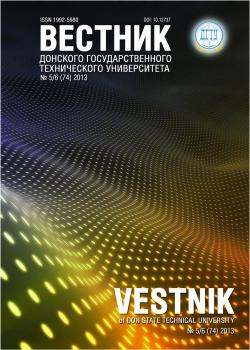The application of the complex artificial neural networks (CANN) to the inverse identification problem of the elastic and dissipative properties of deformable solids is considered. The additional information to the inverse problem is components of the displacement vector measured in a set of points at the solid boundary (positional measurement). This solid performs harmonic oscillations in the first resonant frequency. The process of displacement measurement is simulated using the calculation of finite elements software ANSYS, the building of the amplitude-frequency characteristics (AFC) of the displacement, and of the selection of their values for a set of frequencies (frequency measurement). In the given numerical example, problems on the accurate identification of the elastic modulus, and material quality depending on the number of measure points and their location, as well as on the neural network architecture and the length of the training process performed by the complex-value error back propagation (CBP) algorithm are investigated.
complex-valued artificial neural networks, identification of mechanical properties, finite element method.
УДК 539.3:534.1
Определение упругих и диссипативных свойств материалов с помощью сочетания метода конечных элементов и комплекснозначных искусственных нейронных сетей[1]
А. Н. Соловьев, Н. З. Ч. Занг
Рассматривается применение комплекснозначных искусственных нейронных сетей (КИНС) в обратной задаче идентификации упругих и диссипативных свойств деформируемого твердого тела. Дополнительной информацией для решения обратной задачи являются компоненты вектора смещений, измеренные в наборе точек на границе тела (позиционное измерение), совершающего гармонические колебания в области первой резонансной частоты. Процесс измерения смещений в работе моделируется расчетом в конечноэлементном пакете ANSYS, построением амплитудно-частотных характеристик (АЧХ) смещений и выбором их значений для некоторого набора частот (частотное измерение). В приведенном численном примере исследуются вопросы точности идентификации модуля упругости и добротности материала в зависимости от числа точек измерения и их расположения, а также от архитектуры нейронной сети и длительности процесса ее обучения, который осуществляется с помощью алгоритма комплекснозначного обратного распространения ошибки (КОР).
Ключевые слова: комплекснозначные искусственные нейронные сети, идентификация механических свойств, метод конечных элементов.
Введение. В настоящее время искусственные нейронные сети (ИНС) [1] широко применяются в различных областях науки. В механике они используются для решения коэффициентных и геометрических обратных задач.
[1] Работа выполнена при частичной финансовой поддержке РФФИ (гранты № 13-01-00196-a, 13-01-00943-a).
1. Haykin, S. Neural Network a comprehensive foundation (2nd edition). Prentice Hall. 1998, 842 p.
2. Krasnoshchekov, А. А., Sobol, B.V., Solovyev, A.N., Cherpakov, A.V. Identifikatsiya treshchinopodobnykh defektov v uprugikh elementakh konstruktsiy na osnove evolyutsionnykh algoritmov. [Identification of crack-like defects in elastic structural elements based on evolutionary algorithms.] Defektoskopiya, 2011, no. 6, pp. 6778 (in Russian).
3. Liu, S.W., Huang, J.H., Sung, J.C., Lee, C.C. Detection of cracks using neural networks and computational mechanics. Computer methods in applied mechanics and engineering, 2002, vol. 191, pp. 2831-2845.
4. Hasan, T., Feyzullah, T. An application of neural networks for harmonic coefficients and relative phase shifts detection. Expert Systems with Applications, 2011, vol. 38, iss. 4, pp. 3446-3450.
5. Khandetsky, V., Antonyuk, I. Signal processing in defect detection using back-propagation neural networks. NDT&E International, 2002, pp. 483-488.
6. Xu, Y.G., Liu, G. R., Wu, Z. P., Huang, X. M. Adaptive multilayer perceptron networks for detection of cracks in anisotropic laminated plates. International journal of solids and structures, 2001, vol. 38, pp. 5625-5645.
7. Korczak, P., Dyja, H., Łabuda, E. Using neural network models for predicting mechanical properties after hot plate rolling processes. Journal of Materials Processing Technology, 1998, vol. 80-81, pp. 481-486.
8. Mira, T., Zoran, S., Uros, L. Predicting mechanical properties of elastomers with neural networks. Polymer, 2007, vol. 48, pp. 5340-5347.
9. Ghaisari, J., Jannesari, H., Vatani, M. Artificial neural network predictors for mechanical properties of cold rolling products. Advances in Engineering Software, 2012, vol. 45, pp. 91-99.
10. Iztok, P., Milan, T., Goran, K. Determination of scrap/supply probability curves for the mechanical properties of aluminium alloys in hot extrusion using a neural network-like approach. Expert Systems with Applications, 2012, vol. 39, pp. 5634-5640.
11. Sun, Y., Zeng, W., Han, Y., Ma, X., Zhao, Y., Guo, P., Wang, G. Determination of the influence of processing parameters on the mechanical properties of the Ti-6Al-4V alloy using an artificial neural network. Computational Materials Science, 2012, vol. 60, pp. 239-244.
12. Nitta, T. A back-propagation algorithm for complex numbered neural networks. Proceedings International Joint Conference on Neural Networks, IEEE, Nagoya. 1993, pp. 1649-1652.
13. Nitta, T. An extension of the back-propagation algorithm to complex numbers. Neural Network, 1997, vol. 10, pp. 1391-1415.
14. Hirose, A., River, E. Complex-valued neural networks: Theories and applications. The Series on innovative intelligence. 2003, 388 p.
15. Li, C., Liao, X., Yu, J. Complex-valued wavelet network. Journal of Computer and System Sciences, 2003, vol. 67, pp. 623-632.
16. Nitta, T. Complex-valued neural networks: utilizing high-dimensional parameters. Information Science Reference. 2009, 504 p.
17. Belokon, A.V., Nasedkin, A.V., Solovyev, A.N. Novyye skhemy konechno-elementnogo dinamicheskogo analiza pyezoelektricheskikh ustroystv. [New schemes of finite element dynamic analysis of piezoelectric devices.] PMM, 2002, vol. 66, no. 3, pp. 491501 (in Russian).
18. Novatskiy, V. Teoriya uprugosti. [Elasticity theory.] Moscow: Mir, 1976, 872 p. (in Russian).





